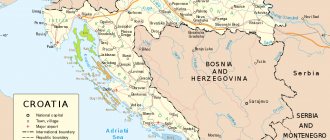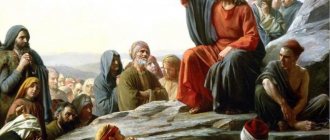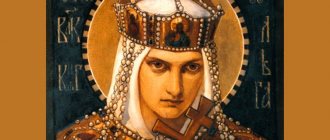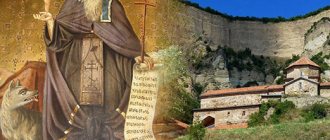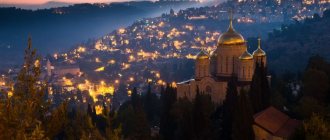Period until the beginning of the 11th century.
The beginning of the preaching of Christianity in the territory of ancient Iberia dates back to apostolic times. According to church tradition, the Mother of God Herself was supposed to preach Christianity in Iberia (for this reason, Iberia is considered one of Her earthly inheritances), but the Lord ordered Her to stay in Jerusalem, and the apostle went to Georgia with Her miraculous image. Andrew the First-Called. He preached in the West. and Yuzh. Georgia; in the territory of the South-West. Georgia (Meskheti) he founded the first episcopal see in the village. Atskuri (near the modern city of Akhaltsikhe). In the West Georgia was also preached by the apostles Simon the Canaanite and Matthias (according to tradition, both were buried in Western Georgia), in the East. Georgia – Apostles Thaddeus and Bartholomew. Thanks to the sermon of St. Equal to the Apostles Nina in 326, during the reign of King Mirian, Christianity was declared official. religion in the kingdom of Kartli, which at that time occupied almost the entire territory of modern times. Georgia. Initially, the Church of Kartli was under the jurisdiction of Antioch, but already in the 480s, under King Vakhtang I Gorgasala (d. 502), who united all of Georgia, Gruz. the church underwent a reorganization and became autocephalous with its center in Mtskheti [obtaining autocephaly during the time of Patriarch Peter of Antioch (c. 469–471, 475–476, 478–479, 485–489) is confirmed by the famous canonist Theodore Balsamon (between 1130 and 1140 - after 1195 )]. An archbishop with the title of Catholicos was placed at the head of the church hierarchy, new dioceses were formed and a Synod was created. From the 520s The Catholicoses of Mtskheta began to elect local clergy instead of the supplied Antioch bishops. The first Catholicos cargo. origin was Sava I (523–532). Zap. Georgia, which in the same period became dependent on Byzantium. empire, also submitted to Constantinople in church-jurisdictional terms.
In the 4th–5th centuries. for cargo language The Gospel, as well as the Psalms, were translated in the 5th century. – Acts of the Apostles, as well as the definitions of the 1st–4th Ecumenical Councils. The appearance of the first original hagiographic works dates back to the same period. works - “The Life of St. Nino" (4th century), "Martyrdom of St. Queen Shushanik" by Yakov Tsurtaveli (last quarter of the 5th century). Starting from the 4th century. Cargo. the church maintains close ties with the Christian centers of the East. The cargo activity was active. monasticism in Palestine, Sinai, Syria, and later on the territory of Byzantium. empire [Cross mon. and mon. St. Nicholas in Jerusalem, Iveron Monastery. on Mount Athos, Bachkovo Monastery. (Bulgaria), etc.]. Means. attention was paid to the cargo. kings and Catholicos-patriarchs of the Church of the Holy Sepulchre.
In cargo. In monasteries abroad, scholar-monks wrote extensive literature and translation. and educational work [Peter Iver, John Laz (5th century), Hilarion Kartveli (1st half of the 9th century), Euthymius, George of Svyatogortsy (11th century), as well as John of Svyatogorets (d. 998 or 1002) , Ephraim Mtsire (c. 1025 – c. 1100), Ioane Petritsi (d. c. 1125), etc.]. Monastic life in Georgia itself began in the 5th century, but received special development in the 1st half. 6th century with the arrival here of 13 Syrian desert fathers, who founded monasteries in different regions of the country. The activities of the Syrian fathers during the era of the struggle of Georgia. The church played a role with Monophysitism. role in strengthening the tradition of Orthodoxy in Georgia (the final break of the Georgian Church with the Monophysite Armenian Church dates back to the beginning of the 7th century). The monasteries founded by Syrian monks (Zedazen, Shiomgvim, Martkop, David-Gareji, etc.) remained the largest centers of cargo throughout the Middle Ages. culture and education. From the 8th century Monastic life became especially widespread in the South-West. Georgia (Meskheti, Javakheti, Tao-Klarjeti), where such large monastic centers as Opiza, Ishkhani, Oshki, Bana, Tskarostavi, Khandzta, Khakhuli, Shatberdi, Zarzma, etc. were founded. Scientific research was conducted here. or T. activities of the most prominent representatives of Georgia. churches: Grigol Khandzteli (1st half of the 9th century), Giorgi Merchuli (10th century), Mikael Modrekili (late 10th century), John-Zosim (10th century), etc.
In the 8th–9th centuries. several appeared on the territory of Georgia. independent eristates (Kakheti, Hereti, Tao-Klarjeti and the Abkhazian kingdom), which fought among themselves for political primacy and unification of all cargo. lands, and a special role was given to Orthodoxy. So, freed from the influence of Byzantium. empire abh. The mtavars (princes), and then the kings, pursued a policy of gradual abolition of the Greek. departments, institutions in their place, new ones, with worship services on the load. language, the creation of a church organization independent from Constantinople - Abkh. Catholicosate (9-10 centuries), - which later entered the jurisdiction of the Mtskheta throne [in the beginning. 11th century The Mtskheta (Kartli) Catholicoses received the title of patriarchs and to this day are called Catholicoses-Patriarchs; the first such Catholicos was Melchizedek I (1001 or 1012–30; 1039–45)].
Main directions of religion
Over the long centuries of its spread throughout the country, Christianity has been modified and rethought. As a result of the work of the thoughts of the spiritual fathers, the church was divided into the main directions professed by the inhabitants of modern Georgia.
Orthodoxy
The majority of the population of Georgia belongs to the Georgian Orthodox Church.
The Georgian Apostolic Autocephalous Orthodox Church ranks among the most ancient churches in the world. According to religious legends, Georgia is the apostolic inheritance of the Mother of God herself, and the Orthodox tradition was formed through the thorny path of martyrdom and persecution that Georgia endured during the military invasions of Muslims.
Today, the Orthodox Church in Georgia has a number of privileges, unlike other movements of Christianity.
Armenian Church
The Apostolic Church of Armenia also has its own diocese in Georgia, since many Armenians have lived there since the time of their resettlement there by King Heraclius at the end of the 18th century. Despite the complex relationships between representatives of all Christian movements, including acts of vandalism against shrines, there are still at least six churches of the Armenian Church in Georgia. The first mention of the appearance of this branch of Christianity in Georgia dates back to the 11th century.
Catholicism
Georgia's first interaction with the Roman Catholic Church dates back to the 7th century, when differences in views on the basic principles of Christianity between the east and west began to take shape. Those parishioners who chose the path of the West for themselves remained adherents of Catholicism, and today in Georgia there are up to 100 thousand believers, up to 30 parishes and Catholic monasteries.
Protestantism
Protestantism penetrated into Georgia not so long ago - at the beginning of the 19th century. The first bearers of this branch of Christianity were visiting Germans, from whom sects subsequently began to break off, which later became full-fledged churches - Adventists, Pentecostals, Baptists, and already at the end of the 20th century, evangelists, Quakers and New Apostles appeared.
Today there are hundreds of Protestants in Georgia, the vast majority of whom are Georgians.
Despite intra-confessional differences in views on the Holy Scriptures, all religious movements in Georgia are Christian. Due to the dominant role of Orthodoxy, Georgians are the closest nation to Russians.
Period 11th–18th centuries
11th–12th centuries – “golden” period in the history of Georgia. churches. During this era, the largest cargo centers were created. theological thought and enlightenment - Gelati Academy [at the Gelati Monastery; founded in the beginning 12th century King David IV the Builder (1089–1125) near Kutaisi], Ikaltoi Academy (in Kakheti), and also defined and resolved by many others. church administration and canonical problems in life Cargo. churches. For this purpose, in 1104, King David IV the Builder convened the Rui-Urbniysky Council, which confirmed the loyalty of Gruz. Church of Orthodoxy. In order to achieve harmony in relations between the Church and the state, David introduced the highest hierarchs and abbots of the largest monasteries into the Darbazi (royal Council), and appointed the bishop of the largest in the West as the head of Mtsignobartukhutsesi (government). Georgia diocese - Chkondidi. In the 13th–14th centuries. Georgia was devastated. raids by Khorezmian troops, as well as the Mongols, which brought the country into decline and plunged it into anarchy. In the 15th century The Byzantine and Trebizond empires fell. Remaining surrounded by Muslims. powers of Georgia, where internecine wars began, towards the end. 15th century broke up into 3 kingdoms (Kartli, Kakheti, Imereti) and the kingdom of Samtskhe-Saatabago. Later in semi-independent politics. units of Abkhazia, Megrelia, Guria and Svaneti, subject to the Imeretian king, took shape. For politics fragmentation was followed by church fragmentation. As a result, in the 15th century. The Abkhazian (West Georgian) Catholicosate arose, virtually independent of the Mtskheta throne, with its center in Bichvinta (now Pitsunda). In the 2nd half. 16th century, due to the strengthening of the Ottoman threat and the onslaught of the mountain tribes of the North. Caucasus, center of Abkhazia. The Catholicosate was moved from Bichvinta to Gelati monastery. Period 16th–18th centuries turned out to be the most difficult cargo in history. churches. For three centuries, Georgia had to wage an almost continuous struggle against the aggression of Iran, Turkey, and from the 17th century. - against the raids of the North Caucasus. feudal lords In literature, this era was given the name “the era of martyrs for the faith.”
History of the Georgian Orthodox Church
Herod's desire to kill all the apostles in ancient Jerusalem led to the fact that the preachers of the Holy Gospel decided to leave their good place. Having gathered, they cast lots as to who should go where. Iberia (Georgia) fell to the Mother of God. But an Angel appeared to the Mother of God and told her that she must remain in Jerusalem. She handed over her mission to the Apostle Andrew the First-Called and gave him her miraculous image.
Saint Andrew traveled a long way to reach Iberia. On his way, he preached the Holy Gospel, performed many miracles, healed the sick and the dead. Many people were baptized. Several more apostles went to ancient Georgia, along with Andrei.
Equal to the Apostles Nina - patroness of Georgia
Our Lady did not forget her duty to care for Iberia. This time, Equal-to-the-Apostles Nina from Cappadocia became her messenger.
Nino's father and mother served in the church. With the blessing of the Patriarch, they gave their daughter to become a nun. Nina, having learned that the Lord's Heaton was buried in Iberia, prayed to the Mother of God to give her the opportunity to get there. The persecution of Christians continued, and Nina fled from Jerusalem. Soon, the Mother of God appeared to her in a dream and sent Nino to bring Christianity to Iberia. Waking up in the morning, she saw a vine cross.
Zion Cathedral, Arab yoke
Zion Cathedral is one of the main temples in Tbilisi. The first church was built in the 6th century by the nobleman Guram I. Only in the 12th century did David IV restore the new temple. The church was destroyed and rebuilt several times. Zion Cathedral is marked by the main relic of Georgia - the cross of St. Nina.
The Georgian lands suffered more than once from the nasty hand of the Arab Khanate. In the 8th century the whole of Iberia was devastated. The church was in danger of disappearing. The conquerors destroyed shrines without hesitation. By the end of the 9th century, Christians began to profess Islam.
Cross of Equal to the Apostles Nino
In the capital of Iberia, Mtskheti, Nina performed many healings and miracles, all thanks to prayer. King Miran wanted to execute the nun, but then a miracle happened. The ruler is blind. Many priests tried to help the king, but to no avail. Nina came to the rescue, she healed Miran, and he had mercy on her. Not long after, the ruler invited Byzantine priests and many people converted to Christianity. From then on (326) it became significant for the Georgian Church - Christianity became the main religion of Iberia.
Graceful times
Georgia has not always experienced difficult times in its history. With the advent of David IV the Builder to the reign, the condition of Georgia and its people improved significantly. The role and strength of the Christian Church was renewed: new churches were built, a theological academy was created, it finally united and became independent.
The peak of Georgia's prosperity was the reign of Queen Tamara. She expanded the geographical possessions of the power from the Black Sea to the Caspian Sea. Georgia was considered the most powerful Christian land in the Eastern Mediterranean. A large number of enlightened people appeared: theologians, philosophers, historians, artists, poets.
Metekhi Temple. Five Hundred Years of Sorrow
Soon, after the death of Queen Tamara, the dawn of the Georgian kingdom was replaced by sorrowful times. First the raids of the Mongols, then the Horde, and after them the Ottoman Turks. The conquerors sought to forcibly convert the people to Islam. Not long after, there was an invasion by the Persians, who for hundreds of years wanted to destroy Orthodoxy.
But it was not only the Muslim people who interfered with the fate of the Orthodox Church. Catholics also wanted to break the faith of Georgians. Repeatedly, the Popes sent their representatives to the kings, with the desire to lure them to the side of the Catholic Church.
Long centuries of persecution led to a split in the Georgian Church and country. Two Catholicosates were formed: the Old - with its center in Mtskheta and the New - in Bichvinta, and then in Kutaisi.
Metekhi Temple is a witness to the raids of the Mongols and Persians. The church was rebuilt in 1278-1284. during the reign of Tsar Demetrius II. Initially, it was a court church. Then, it became part of the fortress, which already under Tsarist Russia turned out to be a prison. More than once the temple was destroyed and rebuilt. In the 20th century The prison was demolished by the Russian authorities, but the church was saved.

